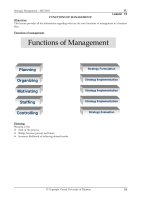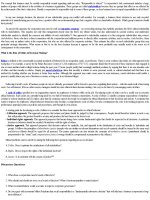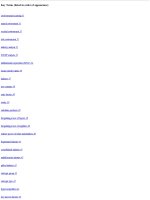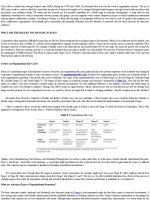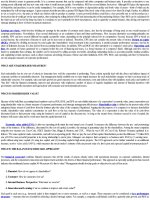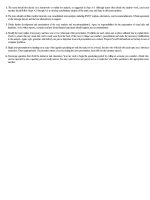strategic management module 23
Bạn đang xem bản rút gọn của tài liệu. Xem và tải ngay bản đầy đủ của tài liệu tại đây (241.64 KB, 47 trang )
Strategic management (module#2 and #3)
박찬희 , 중앙대학교 경영대학 교수
Only for class discussion
Never circulate without permission
Key issues in ‘Strategic Management’
1. Strategic Planning
2. Business Strategy
3. Corporate Strategy
4. Interactive reasoning
5. Strategic Decision Making
6. Strategy Evaluation & Control
7. External Relations
This course will cover…
•
Strategic Planning
–
What is strategy : implication
–
Strategic planning process
–
Financial management as ‘resource planning’
–
Scenario analysis and risk management
–
General manager’s challenge
•
Corporate Strategy
–
Logic of corporate operation
–
Identification of corporate advantage on the valuation chart
–
Corporate resource allocation
•
Business Strategy
–
Logic of business strategy and competitive reactions
–
Generic strategies : role of financial information
–
General manager’s challenge
•
Strategic Decision Making
–
Why do good managers choose poor strategies?
–
Significance and limitation of ‘system and process’
–
General manager’s challenge
•
Interactive Reasoning
–
Lessons from ‘applied game theory’
–
Real world solutions
–
Further reflections
•
Strategy Evaluation and Control
–
Why is control something more than numbers?
–
General manager’s challenge
–
Role of managerial discretion and judgment
•
External Relations
–
How to deal with the challenges from ‘external environments’?
–
PR / GR / IR
–
General manager’s challenge
–
Implication for working-level managers
Business Strategy
Porter’s 5-force model: application of ‘Bain IO’
- heritage of ‘structure-conduct-performance’ models
Business Strategy (1)
Strategy: what to do vs. how to do (Review)
•
General manager’s challenge
–
Strategy : What to do
–
Structure & Process : How to do
–
Making things done through people
•
Relative importance of ‘industry choice’?
–
Between-industry difference vs. within-industry difference
–
Firm heterogeneity and role of management
–
Competence, resource, strength… (all the same)
–
Critical problems of ‘industry importance’ arguments…
•
Only the living species are counted
•
Fit with own skills and resources…
•
Strategy from within vs.strategy from outside-in?
–
Discussions on ‘competitive advantage’ or ‘resource
–
No more than academic masturbation!!!
Vision
Capability Environment
Strategy
Performance
Sustainable
Advantage
Basic framework typically adopted in so and so classes…
Where does 5-force model fit?
Vision, goal, strategy?
The Industry
Rivalry among
Existing Players
Threats from
New Entrants
Threats from
Substitutes
Bargaining
Power of Buyers
Bargaining
Power of Suppliers
Porter’s Five-Force Model
Porter’s Five-Force Model
Porter’s Five-Force Model: Practical Tests
Porter’s Five-Force Model: Practical Tests
•
Rivalry among existing competitors: ‘concentration’
Rivalry among existing competitors: ‘concentration’
–
Factors affecting the intensity of rivalry
•
Industry growth, fixed costs, product differences, brand identity, switching
cost, corporate stakes, exit barrier, capacity utilization…
–
Exit Barrier : specialized assets, exit cost, strategic/emotional barriers,
governmental & social barriers…
•
Threats from New Entrants
Threats from New Entrants
–
Entry Barrier
•
Source: cost advantage, customer value, established relationship,
competitor action, uncertain imitability
•
First mover’s advantage vs. Pioneering cost
•
Minimum efficient scale
–
Comparison with Boxing Fights or Battles…
•
Power of Buyers
Power of Buyers
–
Intrinsic Bargaining Strength
•
Buyer concentration, volume of purchases, switching cost, alternative
products, buyer information, threats of backward integration, pull-
through to end customers
•
Impact of the recent industry changes shows the dynamism in the market
place
–
Price Sensitivity
•
Cost/total purchases, product differentiation, impact on
quality/performance, buyer strategy, buyer profitability
•
Power of Suppliers (reversed logic)
Power of Suppliers (reversed logic)
–
Supplier concentration, supplier volume, substitute inputs, product
differentiation, switching cost, buyer information, threat of forward
integration, pull-through…
Porter’s Five-Force Model: Practical Tests
Porter’s Five-Force Model: Practical Tests
•
Threats of Substitutes
–
Often, more dangerous…
•
Paradigm-breaking substitutes come surreptitiously and suddenly
•
Narrow definition of industry leaves blindside
•
Broad definition of industry distracts competitive focus
–
What are they?
•
Direct substitution
•
Doing without
•
Using product less intensively
•
Backward / Forward Integration
Porter’s Five-Force Model: Practical Tests
Porter’s Five-Force Model: Practical Tests
Caveats of Competitive Strategy
Caveats of Competitive Strategy
•
Lessons
–
Obsession with ‘advanced technology’ or ‘high growth’ is dangerous
–
Technology for the sake of technology is dangerous
•
Caveats
–
Need for industry expertise
–
Need for information
–
Need for dynamic analysis (esp. dynamic & discontinuous change)
–
Play YOUR game
•
Dell Computer
–
PC manufacturing as of 1995
–
Michael Dell’s new concept
–
Impact on the industry structure
•
Electronic Storage
–
Evolution of floppy disk industry
–
Emergence of electronic storage devices
–
Substitute pressure
•
Blue Ocean?
( 참고 ) Dong-A Business Review 2008.02: ‘ 블루오션은 없다’ )
Thought Experiment
Thought Experiment
Competitive Advantage
Competitive Advantage
•
Re-interpretation of ‘strategy’ in terms of ‘advantage’
–
Competencies
•
Resource Definition: Firm = Bundle of Resources
•
Activity Definition: Firm = Set of Discrete Activities
–
Value Chain Analysis
M
A
R
G
I
N
Firm infrastructure
Human resource management
Technology development
Procurement
In-bound
logistics
Manu-
facturing
Out-bound
logistics
Marketing
& Sales
Service
Fundamental activities
Supporting
activities
Concept of Value Chain
Inter-relationship among the value activities : source of synergy creation
Identification of the interrelationship among the value
Interrelationship among the value chains
Competitor
Supporting firms
Supplier End consumerDistributor‘Firm at the center’
Vertical relationship
Vertical relationship
Horizontal
Horizontal
relationship
relationship
Diagonal
Diagonal
Forward
Forward
Backward
Backward
•
Financial advisory
Financial advisory
•
Advertising agency
Advertising agency
•
Marketing research
Marketing research
Business Strategy (2)
-
Generic Strategies
-
Sustainability
Willingness to Buy
Opportunity Cost
•
Low Cost vs. Differentiation
–
Low Cost = Low Margin? Differentiation = High Margin? NO!!
–
Economic Reasoning: Raise WTB and lower OC
•
Focus vs. Stuck-in-the-Middle
•
Differentiation & Low Cost for What? (Need to reflect against ‘goal’)
Generic Strategies
Generic Strategies
Cost Leadership Strategy
Cost Leadership Strategy
•
Cost Leadership Strategy
–
Cost leadership over competitors larger room for margin
–
Managing key cost drivers
•
scale, learning, capacity utilization, linkages, integration, timing, location
•
Interrelationship, institutional factors
•
Depending on the nature of the game
•
Common Pitfalls
–
Not a simple accounting control
–
Need to understand operational details
–
Incremental change is often dangerous
•
Concept
–
Differentiation points over competitors larger room for ‘premium margin’
–
Usually a result of ‘innovation’ (incurring higher cost)
•
Planning & Implementation
–
Lowering buyer’s cost or raising buyer’s performance
–
Need to understand buyers
•
Common Pitfalls
–
Cost implication
–
Competitive reaction
Q: Is there anybody who truly likes your innovative success?
Differentiation Strategy
Generic Strategies (2)
Generic Strategies (2)
•
Focus Strategy
–
Choosing a narrower battle field
•
Play your game
•
Mobility Barrier
–
Examples
•
Product features
•
Location
•
Customer value
–
Alignment of organization and system with the target Segment
•
Some Caveats
–
Too wide vs. Too narrow
–
Shifting nature of the business segment
Generic Strategies : Synthesis
Generic Strategies : Synthesis
•
Pursuing multiple generic strategies?
–
Stuck in the Middle?
–
Possible only if
•
Strong positional advantage or capability
•
Stupid competitors
•
Real world problems
–
Low cost is painful
–
Differentiation incurs risk-taking
–
Focus also needs courage
•
System alignment
–
Inertia
–
Administrative Heritage
Positioning
Positioning
•
Positioning = Scope Decision
–
Extent of business/market coverage
–
Extent of activity coverage
–
Sustainability of Position = Sustainability of Return
–
No interactive considerations + No revisions / learning
–
Point: position sustainability and threats
•
Re-interpreting the concepts of strategy through ‘scope’
•
Sources / Threats of Sustainability
–
Source: value / scarcity / excludability /
–
Threats: Imitation / Substitution / Holdup / Slack
Sustainability
Sustainability
•
What makes Imitation difficult?
–
Imitation
•
New entry
•
Imitated ensemble of activities or resources
–
Prevention : Early mover advantage
•
Private information
•
Size economies : scale, learning, scope
•
Enforceable contracts
•
Threats of retaliation
•
Response lags
•
Substitution
–
Drivers
•
Technology shift
•
Changes in market taste
•
Changes in relative prices
–
Prevention
•
Defend / Switch / Skim

